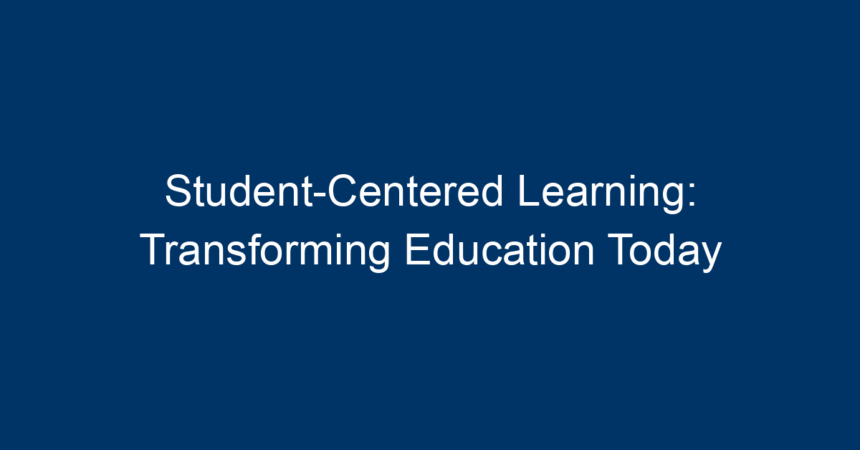In a rapidly changing world, education must evolve to prepare students not just for exams, but for life. Traditional teaching methods often leave students passive recipients of information. However, student-centered learning has emerged as a transformative approach that prioritizes the needs, interests, and experiences of students. This article explores the principles, benefits, and implementation strategies of student-centered learning, highlighting its role in reshaping today’s educational landscape.
What is Student-Centered Learning?
Student-centered learning places students at the heart of the educational process. Unlike traditional models where teachers are the primary source of knowledge, this approach encourages students to take charge of their own learning. It fosters critical thinking, creativity, and collaboration, allowing students to engage deeply with the material.
Key Principles of Student-Centered Learning
-
Active Participation: Students are actively involved in their learning. This can include group discussions, hands-on activities, and projects that encourage exploration.
-
Personalized Learning: Every student has unique strengths, weaknesses, interests, and learning styles. Student-centered learning adapts to these individual differences, allowing for tailored instruction.
-
Collaboration and Communication: In a student-centered classroom, collaboration is essential. Students work together to solve problems and communicate their ideas effectively, preparing them for real-world scenarios.
- Reflection and Assessment: Continuous reflection helps students evaluate their progress. They are encouraged to set personal goals and assess their understanding through self-assessment and peer feedback.
Benefits of Student-Centered Learning
The shift to student-centered learning offers numerous benefits for students, educators, and educational institutions alike.
Improved Engagement and Motivation
When learning is relevant to students’ lives, they are more likely to engage with the material. By incorporating their interests and experiences into lessons, educators can spark curiosity and motivation.
Enhanced Critical Thinking Skills
Student-centered learning promotes critical thinking and problem-solving skills. Instead of memorizing information, students are challenged to analyze, synthesize, and apply knowledge creatively.
Greater Knowledge Retention
Research shows that when students are actively involved in their learning process, they retain information more effectively. Engaging with the material through discussions, projects, and hands-on activities solidifies their understanding.
Development of 21st Century Skills
Skills such as collaboration, communication, creativity, and critical thinking are essential in today’s workforce. Student-centered learning environments foster these skills, preparing students for future success whether in higher education or careers.
Implementing Student-Centered Learning
Transitioning to a student-centered learning environment requires thoughtful planning and commitment from educators. Here are some strategies for effective implementation:
Create a Flexible Learning Environment
A conducive learning environment is key. Classrooms should be arranged to facilitate collaboration, with flexible seating and resources accessible to all students. Technology can also enhance the learning experience, providing various ways for students to engage with content.
Develop Learner-Centered Curriculum
Curriculum design should prioritize student interests and real-world applications. Incorporating project-based learning, where students explore meaningful questions or challenges, can lead to deeper understanding and engagement.
Foster a Growth Mindset
Encourage students to view challenges as opportunities for growth. By celebrating effort and resilience, educators can help students develop a positive attitude toward learning, which is vital in a student-centered learning approach.
Utilize Formative Assessments
Regular formative assessments allow educators to gauge student understanding and adjust instruction accordingly. Techniques like exit tickets, peer reviews, and reflective journals provide valuable feedback that supports student growth.
Encourage Student Voice and Choice
Empowering students to make choices about their learning fosters ownership and accountability. Allowing them to select topics for projects or choose how to demonstrate their understanding encourages autonomy and intrinsic motivation.
Overcoming Challenges
Despite its numerous benefits, implementing student-centered learning comes with challenges. Below are some common obstacles and how to overcome them.
Resistance to Change
Transitioning from traditional methods can meet resistance from educators accustomed to conventional teaching. Professional development and collaborative workshops can help build enthusiasm and provide the necessary skills for effective implementation.
Classroom Management
With increased student autonomy comes the need for strong classroom management strategies. Establishing clear expectations and routines, along with fostering a respectful learning environment, can help maintain order while encouraging independent learning.
Resource Limitations
Schools may face limitations regarding resources and technology. However, many principles of student-centered learning can be implemented with minimal resources through creative planning and community partnerships.
Real-World Examples of Student-Centered Learning
Success stories around the globe exemplify the impact of student-centered learning:
Project-Based Learning at High Tech High
High Tech High, located in California, uses project-based learning as its fundamental model. Students tackle real-world issues through collaborative projects, promoting deep engagement and practical skill development.
Inquiry-Based Learning in Finland
Finland’s education system, renowned for its innovative practices, heavily emphasizes student-centered learning. Finnish students engage in inquiry-based work that encourages critical thinking and supports individual interests.
Actionable Insights for Educators
As you consider implementing or enhancing student-centered learning strategies in your classroom, keep the following insights in mind:
-
Start Small: Begin with one or two strategies. As you gain confidence, gradually integrate more elements of student-centered learning into your teaching practices.
-
Engage in Professional Development: Continuous learning is vital. Attend workshops, join networks, or pursue certifications in innovative teaching methods to enhance your skills.
-
Collaborate with Peers: Sharing experiences and strategies with colleagues can foster a supportive environment and inspire new ideas for engaging students.
-
Invite Feedback: Regularly seek feedback from your students. Understanding how they view their learning experiences allows for adjustments that enhance engagement and effectiveness.
- Celebrate Successes: Acknowledge and celebrate the achievements of both students and yourself in this learning journey. Celebrating milestones reinforces a positive culture around learning.
Conclusion
Student-centered learning is more than just a trend; it represents a profound shift in the educational paradigm. By engaging students as active participants in their learning journeys, we can foster critical thinkers, lifelong learners, and empowered individuals ready to navigate the complexities of the modern world. Embracing this approach requires commitment, flexible strategies, and a genuine desire to meet the needs of every learner. As educators, parents, and community members, we all have a role to play in this transformative movement, shaping the future of education together.




